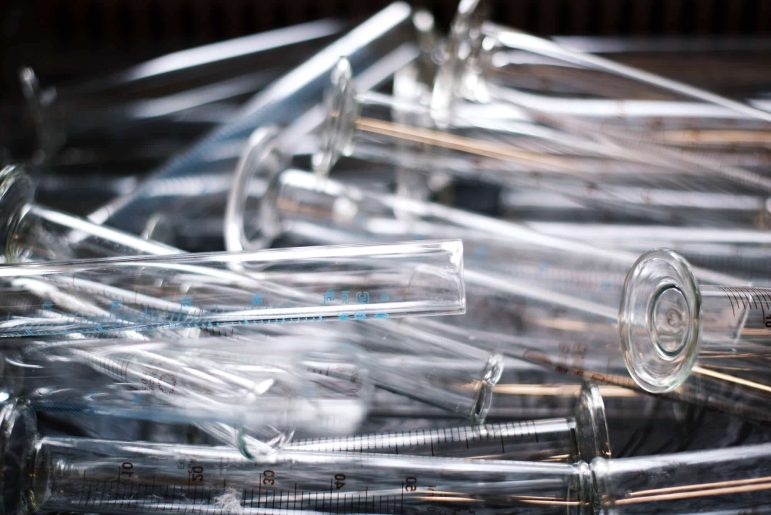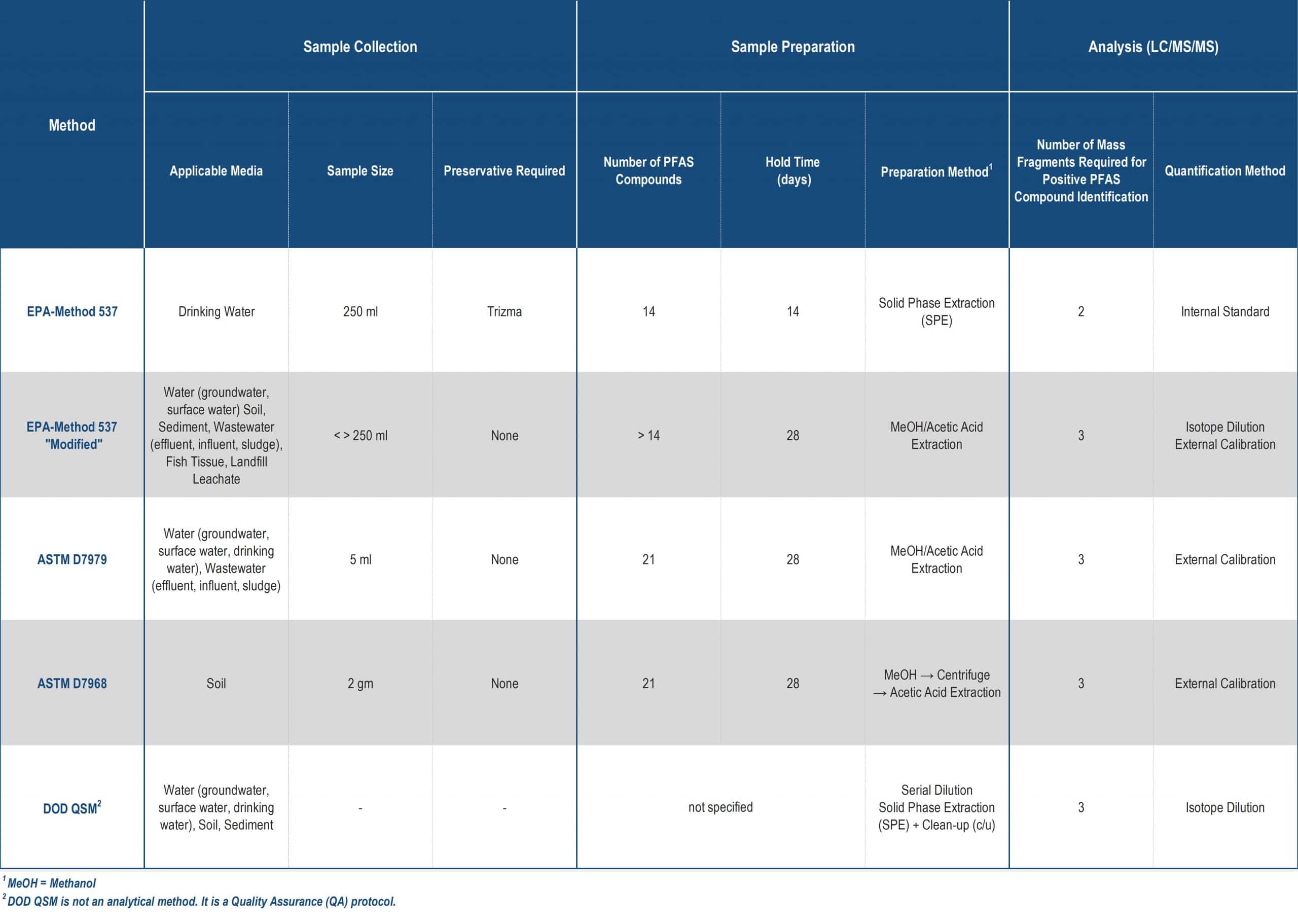PFAS Analysis – The New Wild West
Confusion around PFAS analysis can be overwhelming, and it can feel like the “Wild West.” However, if you ask certain key questions, you can find the right lab to help you with your PFAS investigation.
By Carrie Turner, Senior Project Engineer (Ann Arbor, MI )
August 9, 2018
Per- and poly-fluoroalkyl substances (PFAS) have emerged as a public health concern due to exposure primarily from contaminated drinking water. New studies have identified threats to the environment and other ways humans are exposed to PFAS. Concern over PFAS in the environment has brought about a need to analyze samples from soil, sediment, groundwater, surface water, wastewater, industrial processes, landfill leachate, fish tissue, and other environmental media. There is also pressure to analyze more PFAS compounds and to reach lower, more sensitive quantitation levels as new guidelines and criteria are promulgated. The recently published draft Toxicological Profile for PFAS from the Federal Agency for Toxic Substances and Disease Registry (ATSDR) may result in lowering current criteria levels and accelerate the need to reach lower quantitation levels. Compounding all of this is the fact there are currently no EPA-approved laboratory methods to measure PFAS in media other than drinking water. In addition, the recent regulatory focus on PFAS has motivated many commercial labs to start offering PFAS analysis, as mentioned recently in the news.
All of this can lead to countless questions when planning a PFAS investigation: What analytical methods are available? Which should be used? How do you choose a lab? Are they all the same? This article attempts to explain the terminology associated with PFAS analysis and provide recommendations for choosing a suitable laboratory.
Do you know what questions to ask to help you find the right lab for your PFAS investigation?
The “Wild West”
The only EPA-approved method for PFAS analysis is method 537 v 1.1 (hereafter “EPA-Method 537”), which is conducted using liquid chromatography tandem mass spectrometry, or LC/MS/MS. However, it is only approved for drinking water, and it only measures 14 out of hundreds of PFAS chemicals (1,2). In response to the need to analyze media other than drinking water and address other project interests such as lower quantitation limits, most commercial laboratories have modified EPA-Method 537. This has created a “wild west” type of atmosphere where individual laboratories are developing their own procedures with little coordination between laboratories. Although EPA has recognized the situation (3,4) and is making strides to remedy it, organizations needing PFAS testing, in the meantime, need to ensure their data will withstand regulatory and public scrutiny. Some points to note are:
- Laboratories that have modified EPA-Method 537 for environmental media (or other reasons) will usually, logically, call it method “537 Modified” or “537M”.
- Other methods exist, such as ASTM D7968-14 (for soil) and ASTM D7979-15 (Water – groundwater, surface water, drinking water, Wastewater – effluent, influent, sludge). Like the EPA-Method 537 and 537 Modified analyses, these methods also use LC/MS/MS.
- The Department of Defense (DoD) has promulgated quality assurance procedures for PFAS analysis in Table B-15 of their Quality Systems Manual (QSM) 5.1. You may hear people refer to a “QSM 5.1” analysis; however, this is not an analytical method but a Quality Assurance (QA) protocol.
…there are currently no EPA-approved laboratory methods to measure PFAS in media other than drinking water.
The “537 Modified” method is the most common commercially available method, but it’s important to note that 1) method 537 Modified is not a standard or EPA-approved method; and 2) the modifications can vary from lab to lab. Modification(s) to the EPA-Method 537 may refer to one or more of these situations:
- The media is not drinking water;
- The sample preservative or volume differs from EPA-Method 537 requirements;
- The analyte list includes additional PFAS compounds beyond the 14 listed in EPA-Method 537 and the list of additional compounds may vary between laboratories – most national labs are now routinely quantifying 24 PFAS compounds;
- The quantitation method is not the internal standard method (alternatives include isotope dilution and external calibration methods);
- Differences in sample collection, preparation or analysis procedures from those described in EPA-Method 537; and/or,
- Other Quality Assurance/Quality Control (QA/QC) requirements.
A comparison of the methods and points in the sampling and analytical procedures where departures from EPA-Method 537 can occur are summarized in the Table below.
One of the major points of confusion in PFAS analysis arises from the terminology used around quantitation methods. “Isotope dilution” is generally regarded as the “gold standard” of quantitation. It is the most robust, sensitive and accurate of the three quantitation methods commonly used, so it gets touted as a selling point to demonstrate the rigor of a laboratory’s method. However, this term can have different meanings from lab to lab. The gold standard version means each PFAS target analyte is quantitated relative to its isotopically labeled equivalent (e.g., the carbon-13 isotope of perfluorooctane sulfonic acid [C13-PFOS] is used to quantitate perfluorooctane sulfonic acid [PFOS]). The term can also be used to describe the same quantitation procedure using isotopes that are structurally similar but not the exact isotope of each target analyte. This reduces analytical costs because fewer isotopes are added to each sample. Finally, it is easy to get confused because isotopes are also used in the internal standard quantitation method used in EPA-Method 537. The internal standard method uses a different calculation procedure for quantitation than isotope dilution. Another key difference is in the isotope dilution approach, the isotope standards are added to the sample at the time of extraction, which accounts for variability in analytical technique and matrix effects. In contrast, in the internal standard method, the isotope standards are added at the time of analysis.
Note: the chemistry, analysis and quantitation of various PFAS methods will be the topic of a future article.
Recommendations for Finding a Good Laboratory
Because laboratories tend to all use the same jargon around PFAS analysis (“isotope dilution”, “537 Modified”) but with different specific procedures, it can be challenging to determine if a given laboratory’s PFAS analytical procedure is right for your project needs. At LimnoTech, we recommend interviewing laboratories when planning a PFAS sampling program to make a better-informed lab selection. At a minimum, we recommend the following top five questions you should ask any prospective laboratory, in addition to the standard questions about cost and turnaround time:
- If method 537 Modified is being used as the analytical method, what aspects of EPA-Method 537 have you changed in your 537 Modified method? [see Table for examples of how EPA-Method 537 and 537 Modified method differ]
- Are you quantitating PFAS using isotope dilution and, if so, how many isotopically labeled standards are you using? [the more, the better]
- What is your standard PFAS analyte list? [compare to your state or regulatory program requirements]
- Do you routinely include the QSM Table B-15 requirements in your analytical procedures for PFAS? If not, what QA/QC measures and performance criteria do you rely on for ensuring reliable PFAS results? [QSM B-15 adds a measure of consistency and more QA/QC requirements than EPA-Method 537 – it is regarded as having the most rigorous QA/QC requirements]
- What PFAS-related certifications or performance evaluations have you successfully achieved? [having an external validation of lab performance increases confidence and acceptance by other parties]
Additional questions that may help you identify the best lab for your needs include:
- Under what circumstances would you run a PFAS analysis using internal standards versus using isotope dilution? [good way to tease out laboratory expertise and familiarity with these methods – are they using isotope dilution and move to internal standard method only if circumstances require]
- What regulatory agencies have you worked with related to PFAS analysis? [you may want to work with the same lab your regulator is familiar with to increase their comfort level and acceptance of your data]
- Is there a cost difference between an analysis using internal standards versus using isotope dilution? [isotope dilution should be more expensive because of the higher number of isotopic compounds added to each sample – this is a way to establish a basis for comparing costs]
- Are you using all available branched and linear quantitation standards to improve method accuracy? [a compound like PFOS can have 11 different isomers – each can respond differently in the analysis]
- How many years of experience do your chemists performing PFAS analysis have with LC-MS-MS analysis and isotope dilution quantitation? [the more, the better]
- What practices do you employ in the laboratory and in the analysis to avoid and identify contamination?
- What is your standard turnaround time for PFAS analysis, are expedited turnaround times available, and what is the associated cost(s)? [due to demands, some laboratories are operating at or near capacity and have reported that expedited turnaround is not currently possible]
Because laboratories tend to use the same jargon around PFAS analysis (“isotope dilution”, “537 Modified”) but with potentially different meanings, it can be challenging to determine if a laboratory’s PFAS analytical procedure is right for your project needs.
Each project is unique and there is no one-size-fits-all solution for analyzing for PFAS. Nevertheless, having a common understanding with your laboratory regarding their analytical procedures and data quality practices will ensure both parties are satisfied with the project outcome.
I hope this article provided useful information and helped to clear up some of the confusion around PFAS lab analysis. If you have questions, please don’t hesitate to contact me at cturner@limno.com. I would be happy to discuss your PFAS-related needs.
This article is the third in a series of articles authored by LimnoTech staff on PFAS-related issues. Follow us on LinkedIn or Twitter (@LimnoTech) and check the News and Media page on our website for more information and updates. Links to the other PFAS articles in this series are provided below:
PFAS – Emerging, But Not New
Sampling for PFAS Requires Caution
Carrie Turner, PE, is a senior project engineer at LimnoTech. Carrie specializes in developing affordable and sustainable solutions for our clients dealing with pollution-related issues. She has 20 years of experience evaluating impacts of pollutant sources on watersheds and in waterways using innovative data and modeling analyses that build on her extensive work in environmental chemistry before joining LimnoTech. Carrie also uses her chemistry background to design and implement sampling programs, conduct laboratory audits, validate data, write Quality Assurance Project Plans, and develop customized databases and data management frameworks that integrate spatial, physical and chemical data by linking them with GIS systems for analysis and visualization.







